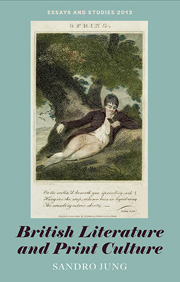Book contents
- Frontmatter
- Contents
- List of Illustrations
- Notes on Contributors
- Introduction
- Tracing a Genealogy of Oroonoko Editions
- The Pilgrim's Progress, Print Culture and the Dissenting Tradition
- Printing for the Author in the Long Eighteenth Century
- Robert Burn's Interleaved Scots Musical Museum: A Case-Study in the Vagaries of Editors and Owners
- Packaging, Design and Colour: From Fine-Printed to Small-Format Editions of Thomson's The Seasons, 1793–1802
- Print Illustrations and the Cultural Materialism of Scott's Waverley Novels
- Beyond Usefulness and Ephemerality: The Discursive Almanac, 1828–60
- The Last Years of a Victorian Monument: The Athenaeum after Maccoll
- Index
Packaging, Design and Colour: From Fine-Printed to Small-Format Editions of Thomson's The Seasons, 1793–1802
Published online by Cambridge University Press: 05 October 2013
- Frontmatter
- Contents
- List of Illustrations
- Notes on Contributors
- Introduction
- Tracing a Genealogy of Oroonoko Editions
- The Pilgrim's Progress, Print Culture and the Dissenting Tradition
- Printing for the Author in the Long Eighteenth Century
- Robert Burn's Interleaved Scots Musical Museum: A Case-Study in the Vagaries of Editors and Owners
- Packaging, Design and Colour: From Fine-Printed to Small-Format Editions of Thomson's The Seasons, 1793–1802
- Print Illustrations and the Cultural Materialism of Scott's Waverley Novels
- Beyond Usefulness and Ephemerality: The Discursive Almanac, 1828–60
- The Last Years of a Victorian Monument: The Athenaeum after Maccoll
- Index
Summary
Like no other text in the eighteenth century, James Thomson's The Seasons demonstrates the socio-economic importance of what James Raven has discussed in terms of product design: booksellers realised that ‘tailoring products to a particular clientele, experimenting in the design and packaging of products, and presenting these, as well as wider publishing activities, as fashionable’ contributed materially to increased sales. At the same time, following the lapse of perpetual copyright, which the pirated reprinting in Scotland of The Seasons had indirectly brought about, a market for the reprinting of works previously controlled by the monopolies of individual booksellers emerged. This proliferating market saw the publication of editions of Thomson's work, in various formats, for a socially diverse buying public. Ranging from relatively cheap, small-format and serialised editions to high-end subscription ventures, the print capital of The Seasons was seen as a testing ground for bookseller-publishers' experiments with marketing strategies, which after 1765 no longer restricted an edition's format to that used by Thomson's formerly exclusive copyright holder, Andrew Millar. The impetus to reprint popular works not only culminated in a large number of competing editions; it also resulted in the formation of a canon of British literature that was underpinned, primarily, by economic considerations regarding available copyright and demand, rather than the recognition of aesthetic merit as a criterion for inclusion in the canon of eighteenth-century literary worthies. Collaboration between booksellers, artists, designers and various trades catering to booksellers' demand for improved materials such as paper and type culminated, in the 1790s, in some of the most impressive ventures in book printing and a range of subscription projects.
- Type
- Chapter
- Information
- British Literature and Print Culture , pp. 97 - 124Publisher: Boydell & BrewerPrint publication year: 2013



